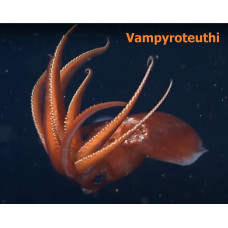Photophores are luminescent organs consisting of clusters of photogenic glandular cells. Photophores are located on different parts of the fish's body (on the sides of the body, on the dorsal fins, at the end of the tail, etc.).
Made up of three layers of cells. The cytoplasm of the cells in the bottom layer contains microscopic crystals of uric acid that reflect light. This layer acts as a reflector. The middle layer is made up of light-producing cells called photoreceptors. The upper layer consists of a transparent cuticle that allows light rays to pass through. In fish, this layer is represented by transparent areas of skin. Photophores often contain bioluminescent bacteria that use carbohydrates and oxygen from the fish's blood to produce light. The result of this reaction is bioluminescence. Photophores can glow continuously because of the photobacteria they contain. In most cases, however, the luminescence of photophores is pulsed and controlled by the nervous system. Luminescence can be of the intracellular or secretory type. In the case of secretory luminescence, the luminescent substance (a mixture of products secreted by two different glands) is secreted from the body in the form of mucus, which covers the animal's body or spreads around it in the water in the form of a luminescent cloud.
Photophores in fish can be found on the head, back, sides of the body, around the eyes and mouth, on various body appendages, antennae, etc. In many pelagic fishes, the first ray of the dorsal fin of females is transformed into a "stick" (illicium) with a luminescent "lure" (esca) at the end. The illicium of different species varies in shape and size. The glowing organ is a gland filled with mucus that encloses bioluminescent bacteria. By dilating the walls of the arteries that supply blood to the gland, the fish can either cause the bacteria to glow, which requires an influx of oxygen, or stop it by constricting the vessels. The glow usually takes the form of a series of successive flashes, which vary from species to species. In the benthic Galatheathauma (Galatheathauma axeli), from a depth of about 3600 m, the glowing "bait" is in the mouth.
Some marine molluscs have photophores and are capable of bioluminescence. These include some unusual snails, such as members of the genus Planaxis and the spectacular cephalopods of the genus Phylliroe. One of the best-known and best-studied luminescent molluscs is the bivalve Pholas. However, the largest number of bioluminescent molluscs belong to the class of cephalopods. There are at least 70 species of squid alone. Several genera of the families Sepiolidae and Loliginidae luminesce due to symbiotic bacteria. The remaining squids are capable of luminescence themselves, using luciferin as the light-emitting substance and the enzyme luciferase, which catalyses the oxidation of luciferin. Cuttlefish have a wide variety of structures involved in bioluminescence. Most have 2 ventral photophores, organs that emit luminescence. The deep-sea squid Vampyroteuthis has such peculiar luminescent organs that it has been recognised as a separate order. In addition to two large mantle photophores and small luminescent organs scattered throughout the body, it is able to emit luminescence with special organs at the ends of its tentacles.
Photophores
Tags: photophores

